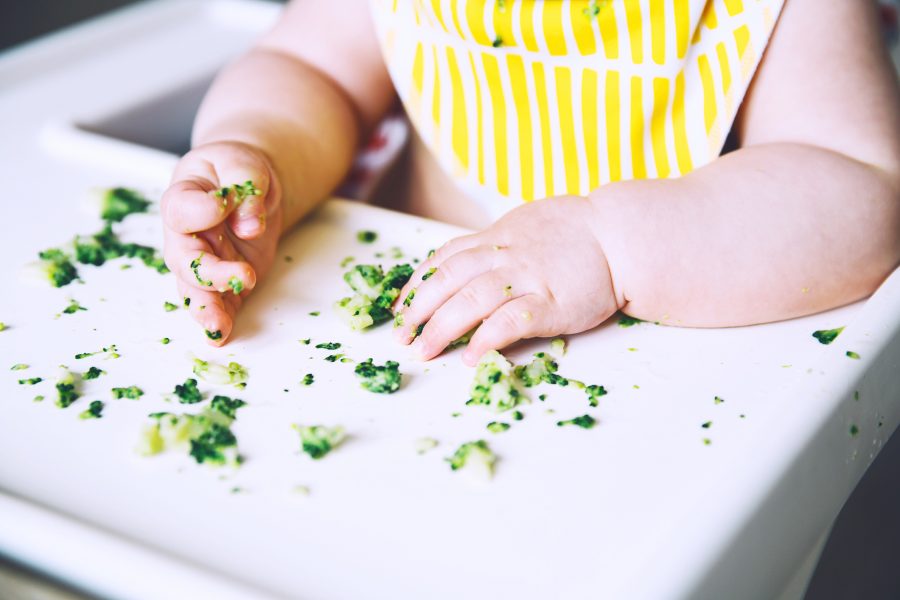
Like most things in parenthood, it feels like the rules around baby food and nutrition is constantly changing.
Like you should have seen my mom’s face when I told her that peanut butter was going to be one of Ben’s first baby foods.. Let’s just say it was similar to the look she gave me when I told her to put him down on his back at nap time. That’s because back when she was raising her own kids, doctors told parents to avoid potential allergens like nut butters and dairy like the plague–and to lay babies on their stomachs to sleep.
Even since I was in grad school for nutrition, things have evolved.
And of course, a simple Google search yields a sea of contradictions. Some experts advise starting solids at four months, others at six. Some say start with rice cereal, others say vegetables. Some say introducing fruits first will cause your baby to only want sweet foods, others say this doesn’t matter. You get the point.
So why so much conflicting information?
1. Because the research is constantly evolving. While kind of a pain, this is a good thing!
2. Because every baby is different.
But here’s what we do know: Giving your little one baby food doesn’t have to be intimidating. It should be fun and exploratory (and it makes for some ridiculously adorable pics–just check out our Instagram account and you’ll see what we mean).
Just follow your baby’s lead–and these simple guidelines sure to help you confidently take the first steps into the world of baby food:
1. Breastfeed First
At this age, solids are more for exposing your baby to tastes and textures than for nutritive value. For the first year, breastmilk or formula should comprise the bulk of your baby’s diet, and solids should gradually take a bigger role.
With that in mind, be sure to nurse your baby or provide formula before offering solid foods. Not only will this ensure she gets the nutrition needed, she will likely be more open to trying new foods when she isn’t ravenously hungry. And try to offer solids when baby is happy and social–they’ll be more receptive.
2. Ditch the Dangers
Avoid honey, raw fish, added sugars, raw milk and choking hazards like whole grapes, peanuts or popcorn.
And always do a temperature test before serving your baby food–remember that this is all new for your little one. The last thing you want to do is make it a negative experience by serving something too hot or too cold.
3. Be Wary of Allergens
Introduce new foods in isolation for a few days before adding something else. Try a new food alone for about three days before combining it with another food or moving on to a new one–to ensure your baby is not allergic.
Signs your little one might be allergic to a new food? Hives, itching, coughing, vomiting, diarrhea, blood in stool.
This might come as a surprised, but it’s important that you introduce common allergens like peanut butter, eggs and citrus fruits early on–research actually suggests that early introduction to these foods may protect against allergy development. watch closely for allergic reactions like respiratory agitation, rashes or swelling of the face, mouth or tongue.
4. Let Your Baby Lead
Although it can be quite messy, letting your baby grab the spoon and sippy cup will help him/her practice and evolve important fine motor skills.
5. Don’t Save Leftovers
Don’t save extra food from that day’s feeding, unless you divide it up before you serve it. The spoon going in your baby’s mouth and back into the food you plan to save = germs/bacteria.
YOU MAY LIKE: 7 Breastfeeding Myths You Have to Stop Believing >
6. Minimize the Mess
Minimize the mess by undressing your baby completely, putting a tablecloth under the high chair and using silicone bibs with a lip to catch extra food. A handheld vacuum can be a lifesaver for cleaning the highchair and the floor around it. Consider wiping down the high chair tray, bib and sippy cup after breakfast and lunch, then do a full clean after dinner. There’s no need to go crazy cleaning when they’re just going to get messy again a few hours later.
7. Make It Easy
Invest in appliances that will make your life easier. The Baby Beaba 3-in-1 baby food maker is a lifesaver in our house since it steams, purees and defrosts baby food. That saves on time and dishes.
Get bowls with suction bottoms, which will stick to the high chair tray when your little one gets handsy.
8. Make More Than You Need
If you’re making your own baby food, prep extra and put it in your freezer, labeling what it is and what date you prepared it.
9. Help Them Go
Constipation is common. If your baby has trouble getting things moving, try serving warm prune, pear or apple purées.
10. Try, Try, Again
If your baby doesn’t seem to like a certain food, don’t give up – it can take many tries.



